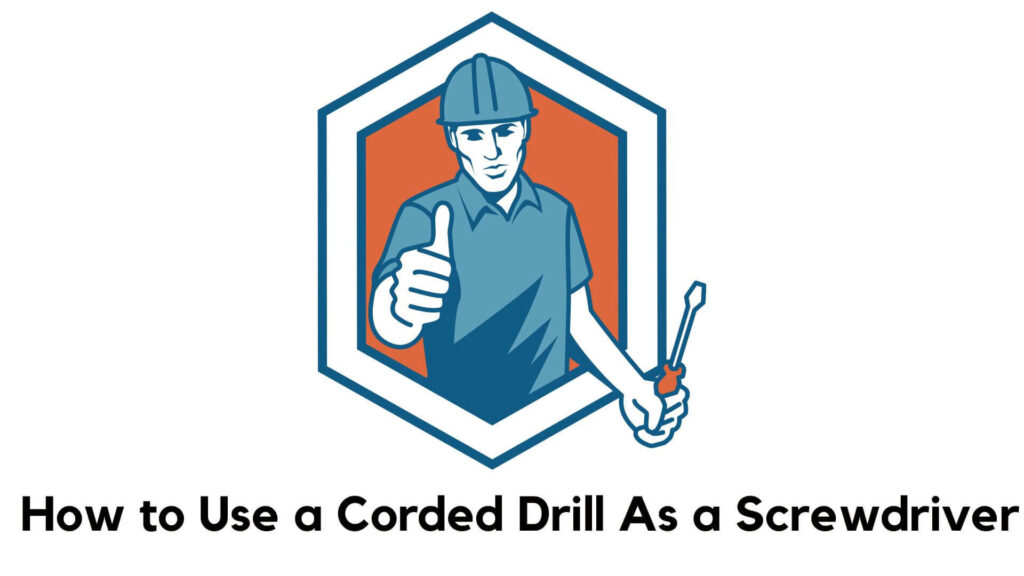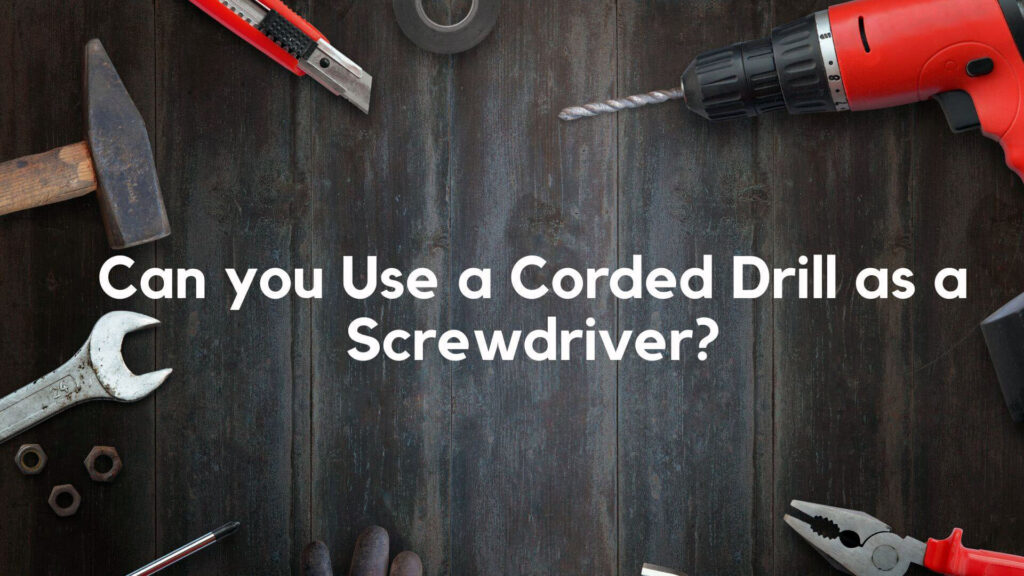Corded drills are primarily known for their drilling capabilities, but they can also serve as a practical solution for driving screws. This versatility makes them an excellent tool for various projects, from simple home repairs to extensive DIY endeavors. In this blog post, we’ll delve into whether you can use a corded drill as a screwdriver, the perfect tasks for it, how to do it effectively, the advantages and disadvantages, and answer some frequently asked questions.
Table of Contents
Perfect Task For Corded Drill as a Screwdriver

Using a corded drill as a screwdriver is particularly effective for several tasks. Here are some scenarios where this can be a perfect solution:
1. Assembling Furniture
When you need to assemble flat-pack furniture or join multiple pieces of wood, a corded drill can quickly drive screws without the tediousness of manual screwdrivers. The power and speed of a corded drill can significantly speed up the process.
2. Installing Drywall
Installing drywall requires numerous screws to secure the boards to wall studs. A corded drill can drive these screws more efficiently than a manual screwdriver, making it easier to cover large areas in less time.
3. Building Decks or Fences
For outdoor projects like building decks or fences, a corded drill can handle longer screws and tougher materials with ease. The power provided by a corded drill is invaluable for these tasks, allowing for quicker assembly.
4. Home Repairs
Whether you’re tightening screws on cabinets, fixing door hinges, or attaching hardware, a corded drill can simplify home repair tasks. It allows you to work more efficiently and achieve better results.
5. Automotive Work
In some automotive applications, you may need to drive screws into metal panels or components. A corded drill can be a handy tool for such tasks, provided you use the right drill bits designed for metal.
Check Also: Best Corded Drill for Home Use.
How to Use a Corded Drill As a Screwdriver :

Using a corded drill as a screwdriver is relatively simple. Here’s a step-by-step guide to help you do it effectively and safely:
Step 1: Gather Your Materials
Before you start, ensure you have the following materials:
- Corded Drill: Make sure it’s in good working condition.
- Screwdriver Bits: Choose the correct bits for the type of screws you’re using (e.g., Phillips, flathead).
- Screws: Select screws appropriate for your project.
- Work Surface: Ensure you have a stable and secure work surface.
Step 2: Prepare the Drill
- Select the Right Bit: Choose a screwdriver bit that matches the screw head. Insert the bit into the drill’s chuck and tighten it securely. If you have a keyless chuck, twist it to secure the bit.
- Set the Speed: If your corded drill has adjustable speed settings, set it to a lower speed. This will give you more control while driving screws and reduce the risk of over-tightening.
- Adjust Torque Settings: If your drill features adjustable torque, set it to a lower value for driving screws to avoid stripping them.
Step 3: Position the Screw
- Mark the Location: Use a pencil to mark where you want to drive the screw. This will help guide you.
- Align the Screw: Hold the screw in place against the material, ensuring it’s straight and aligned with your mark.
Step 4: Drive the Screw
- Start the Drill: Position the bit over the screw head and start the drill. Apply slight pressure as you begin.
- Drive the Screw: Gradually increase the speed as the screw starts to bite into the material. Maintain a steady pressure but avoid pushing too hard.
- Monitor Progress: Keep an eye on the screw as it enters the material. Stop when the screw is flush with the surface or slightly below, depending on your needs.
Step 5: Check for Tightness
- Inspect the Screw: After driving the screw, check to ensure it’s securely fastened without being over-tightened. You can use a manual screwdriver for any final adjustments.
- Repeat as Necessary: If you have multiple screws to drive, repeat the process, adjusting speed and torque as needed.
Step 6: Clean Up
Organize Your Workspace: Clear any debris, screws, or materials to maintain a safe work environment.
Remove Bits: After completing your project, remove the screwdriver bit and store it safely.
Unplug the Drill: Always unplug the drill when not in use to prevent accidental starts.
Check Also: Corded Drills for Wood Workers.
What are the Advantages of Using a Corded Drill as a Screwdriver?
Using a corded drill as a screwdriver comes with several advantages:
1. Increased Speed and Efficiency
Corded drills can drive screws much faster than manual screwdrivers, making them ideal for projects that require driving numerous screws.
2. Powerful Torque
The torque provided by a corded drill makes it easier to drive screws into tough materials, such as hardwoods or metal, with less physical effort.
3. Versatility
Corded drills are not limited to driving screws; they can also be used for drilling holes, making them versatile tools for various projects.
4. Reduced Fatigue
Using a power tool reduces the physical strain on your hands and wrists, which can be especially beneficial when driving many screws.
5. Consistent Results
With the ability to control speed and torque, you can achieve consistent results when driving screws, ensuring they are fastened securely without damage.
What are the Disadvantages of Using a Corded Drill as a Screwdriver?
While there are many advantages, there are also some disadvantages to consider:
1. Over-tightening Risks
One of the most common issues when using a corded drill as a screwdriver is over-tightening screws. This can lead to stripped screw heads or damage to the material.
2. Weight and Size
Corded drills are often heavier and bulkier than manual screwdrivers, which can make them less maneuverable in tight spaces.
3. Need for Power Source
Corded drills require an electrical outlet, which can limit mobility. If you’re working in an area without easy access to power, this can be inconvenient.
4. Noise and Vibration
Corded drills can be noisy and vibrate significantly during use, which can be uncomfortable during extended tasks. It’s essential to wear hearing protection and take breaks as needed.
5. Initial Learning Curve
If you’re accustomed to using manual screwdrivers, there may be a slight learning curve to using a corded drill effectively. Practicing on scrap material can help build confidence.
FAQS about Can you Use a Corded Drill as a Screwdriver
What are the different types of screws that can be used with a corded drill?
You can use various screws with a corded drill, including:
- Wood Screws: Designed for use with wood, these screws have coarse threads for a strong hold.
- Sheet Metal Screws: Made for fastening metal, these screws have sharper threads and points.
- Drywall Screws: Designed specifically for drywall installation, these screws have a bugle head and coarse threads.
- Machine Screws: Used with nuts and tapped holes, these screws are typically used in machinery and automotive applications.
What are the best screwdriver attachments for corded drills?
Some of the best screwdriver attachments for corded drills include:
Socket Adapter: This allows you to use standard socket sizes for driving larger screws or bolts.
Phillips Bits: These are the most common and fit screws with a cross-shaped socket.
Flathead Bits: Ideal for slotted screws, flathead bits are another common attachment.
Torx Bits: These have a star-shaped socket and are used for screws requiring more torque.
Final Thought
Using a corded drill as a screwdriver can be a practical and efficient approach for various projects. With the right technique and precautions, you can harness the power of a corded drill to drive screws quickly and effectively. While there are both advantages and disadvantages, understanding how to use this tool properly can enhance your DIY experience.
Whether you’re assembling furniture, installing drywall, or tackling home repairs, a corded drill can be an invaluable addition to your toolkit, saving you time and effort while delivering consistent results.

Hey, I am MD Hrithik Hossain, I’m a huge fan of DIY crafts. My workshop is where I spend most of my spare time, and I’m always working on some project. To that end, I’d like to share some of my knowledge and experience with you in power tools, woodworking, and other specialized materials fabrication.
I will guide you with genuine knowledge that can assist you with deciding whether a drill is appropriate according to your requirements or not. If you want to find the best drill and know which type of drill is most suited for your needs, then I can guide you with my expertise. My passion lies in helping others find the correct products they need at an affordable price.


